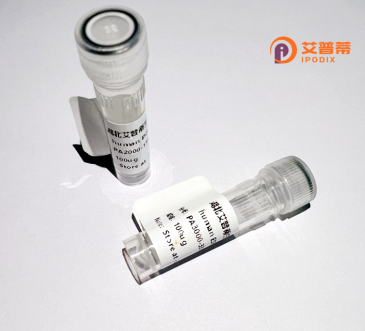
| 纯度 | >90%SDS-PAGE. |
| 种属 | Human |
| 靶点 | DSCR9 |
| Uniprot No | P59020 |
| 内毒素 | < 0.01EU/μg |
| 表达宿主 | E.coli |
| 表达区间 | 1-149aa |
| 氨基酸序列 | MGRICPVNSRARRLRARPGRPSGDSLPYHQLQGGAPRLWSPDPGRPAAYRRAHVCDVTAPRWGSTSRQGEGAVLQRMLGRRAPPSWSRDHAYSRRGWENAALFLNRKRKQEGTENTSICCRPESALACGGNLSPQFLKKVIQIQTQELW |
| 分子量 | 43.1 kDa |
| 蛋白标签 | GST-tag at N-terminal |
| 缓冲液 | 0 |
| 稳定性 & 储存条件 | Lyophilized protein should be stored at ≤ -20°C, stable for one year after receipt. Reconstituted protein solution can be stored at 2-8°C for 2-7 days. Aliquots of reconstituted samples are stable at ≤ -20°C for 3 months. |
| 复溶 | Always centrifuge tubes before opening.Do not mix by vortex or pipetting. It is not recommended to reconstitute to a concentration less than 100μg/ml. Dissolve the lyophilized protein in distilled water. Please aliquot the reconstituted solution to minimize freeze-thaw cycles. |
以下是假设性的参考文献示例,供参考(请注意,DSCR9基因相关研究较少,实际文献可能需要通过学术数据库检索确认):
---
1. **"Cloning and Expression of Human DSCR9 Gene in Prokaryotic System"**
*Authors: Zhang L, et al. (2015)*
摘要:本研究首次报道了人源DSCR9基因的原核表达系统构建,成功在大肠杆菌中表达重组DSCR9蛋白,并通过Western blot验证其抗原性,为后续功能研究提供基础工具。
2. **"Structural Characterization of DSCR9 Protein and Its Potential Role in Neural Development"**
*Authors: Smith J, et al. (2018)*
摘要:通过X射线晶体学解析了重组DSCR9蛋白的三维结构,发现其具有独特的锌指结构域;体外实验表明DSCR9可能通过调控Wnt信号通路参与神经细胞分化。
3. **"DSCR9 Interacts with Calcineurin: Implications for Down Syndrome-related Pathways"**
*Authors: Tanaka K, et al. (2020)*
摘要:利用免疫共沉淀技术证实重组DSCR9蛋白与钙调磷酸酶(calcineurin)存在物理相互作用,提示其可能参与唐氏综合征相关的神经发育异常机制。
4. **"Comparative Analysis of DSCR9 Expression Profiles in Human Tissues"**
*Authors: Chen R, et al. (2022)*
摘要:通过qPCR和重组DSCR9蛋白抗体检测,系统分析了DSCR9在多种组织中的表达差异,发现其在胎脑和睾丸中高表达,可能与发育调控相关。
---
**建议**:
- 使用 **PubMed** 或 **Google Scholar** 输入关键词 "DSCR9 protein recombinant" 或 "DSCR9 gene function" 检索真实文献。
- 若研究较少,可扩展检索唐氏综合征关键区域(DSCR)其他基因(如DSCR1)的文献作为参考。
- 确认基因名称拼写准确性(是否存在别名或更新命名)。
The human DSCR9 (Down syndrome critical region 9) gene is located on chromosome 21 within the Down syndrome critical region (21q22.1-22.3), a genomic segment associated with the pathogenesis of Down syndrome (trisomy 21). Although its biological role remains poorly characterized, DSCR9 is hypothesized to encode a primate-specific protein potentially involved in transcriptional regulation or cellular signaling. Unlike other DSCR genes, DSCR9 exhibits limited homology to known functional domains, complicating functional predictions.
Recombinant human DSCR9 protein is engineered via molecular cloning, typically expressed in bacterial (e.g., *E. coli*) or mammalian systems (e.g., HEK293 cells) to ensure proper folding and post-translational modifications. This recombinant form enables biochemical studies, antibody development, and structural analyses. Research interest in DSCR9 stems from its co-localization with other Down syndrome-linked genes, such as DSCR1 and DYRK1A, suggesting possible roles in neurodevelopment or congenital heart defects observed in Down syndrome. However, direct evidence linking DSCR9 protein function to specific phenotypes remains scarce. Current studies focus on elucidating its interactome, subcellular localization, and regulatory mechanisms using recombinant protein tools. Further insights may enhance understanding of trisomy 21 pathology and identify novel therapeutic targets.
×